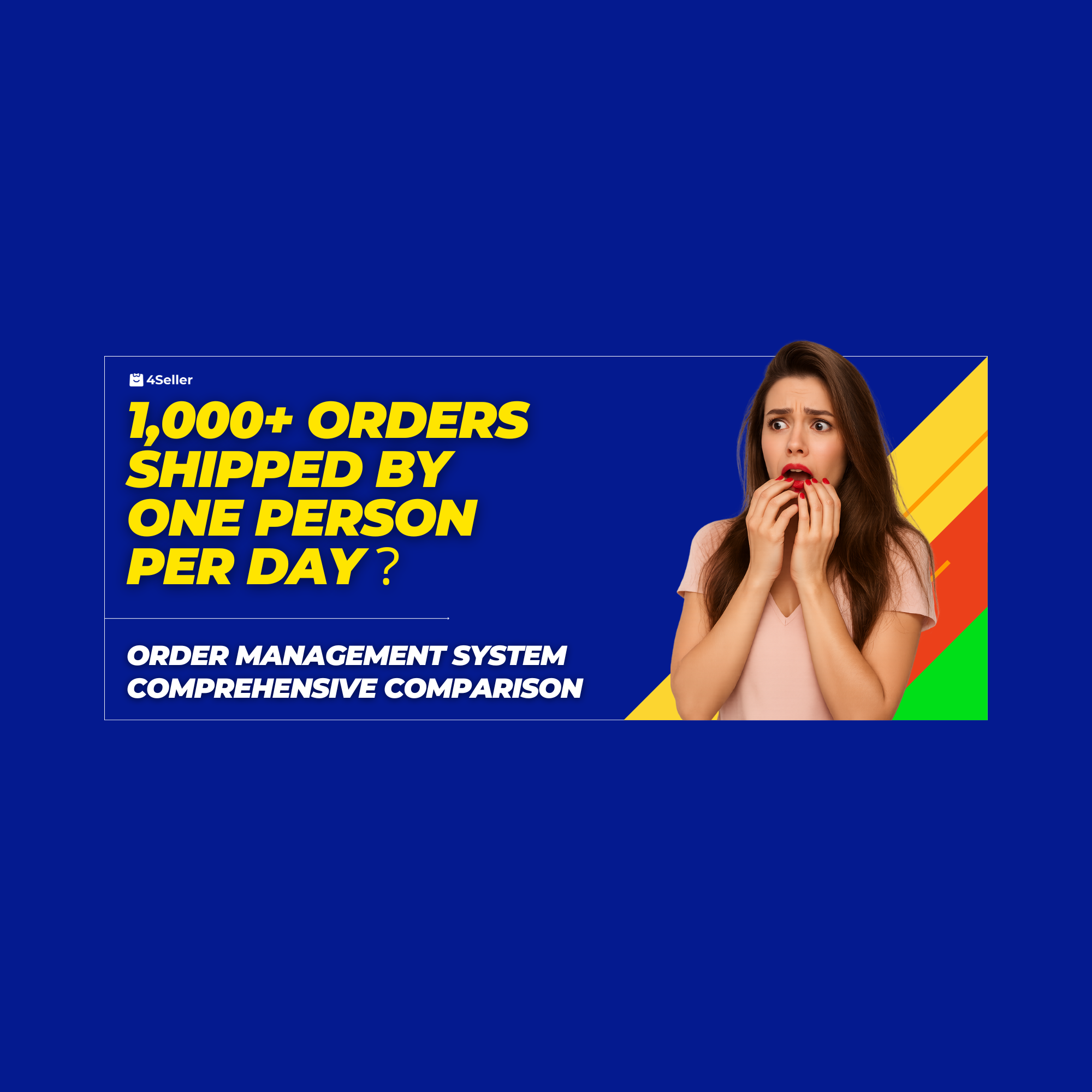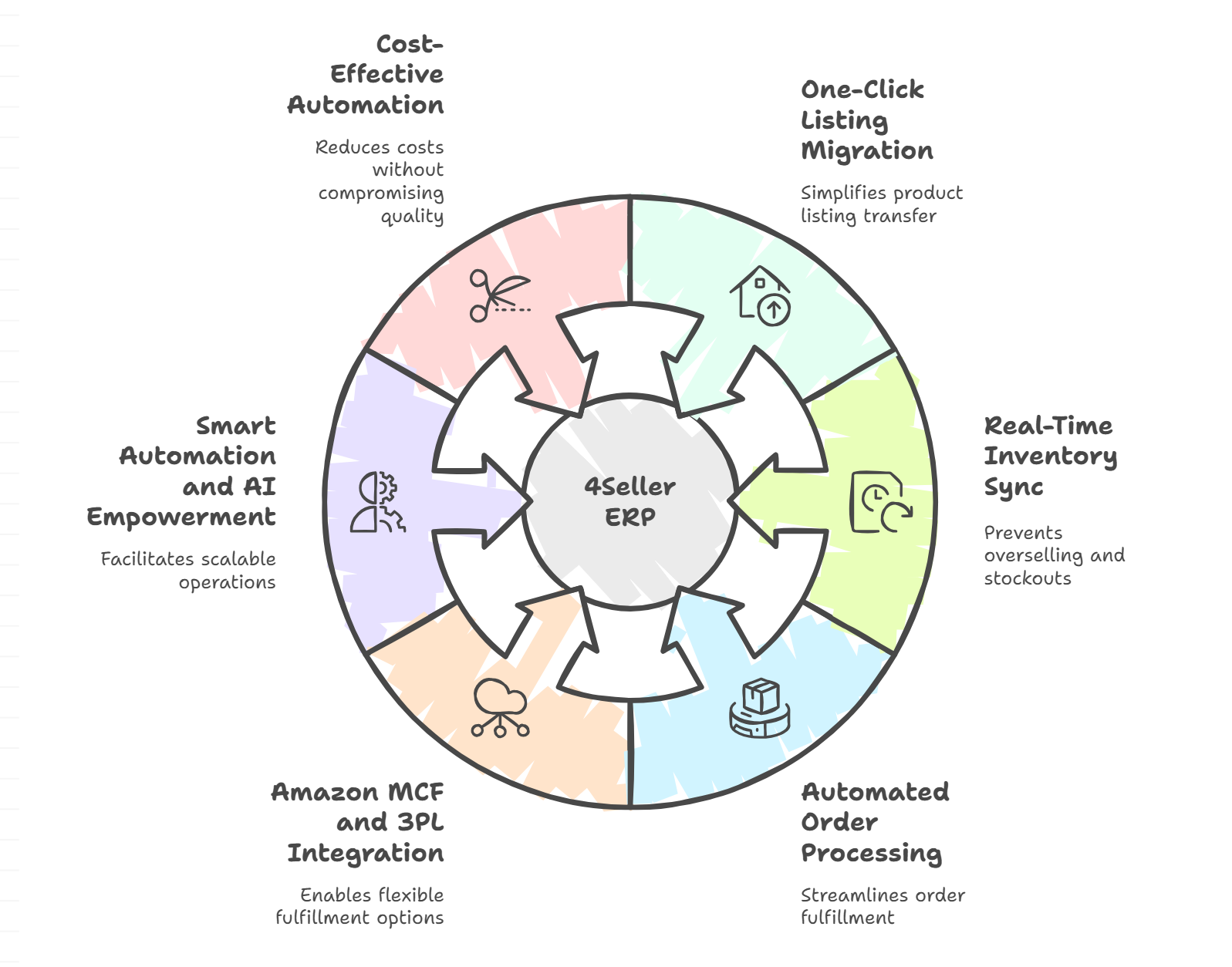- Order Management
- TikTok Shop
- Temu
- About 4Seller
- Amazon
- Shopify
- Inventory Management
- Amazon MCF&FBA
- Amazon Shipping
- UPS
- FedEx
- DHL Express
- Listing Management
- Creator Bulk Invite
- GLS
- Seller Tips
- eBay
- Shein
- Marketplace News
- Royal Mail
- Amazon MCF
- Walmart
- Multi-channel Store
- Logistics Rule
- Shipping Integration
- Stripe Tracking Sync
- Poste Italiane
- UniUni
- USPS
- PayPal Tracking Sync
- OTTO
- Walmart WFS
- Yodel
- Kaufland
- BRT
- CaiNiao
- Chronopost
- CIRRO
- Correos
- Correos Express
- Deutsche Post
- DHL Parcel
- Etsy
- Evri
- GOFO
- Inventory Sync
- Beginner Tutorial
- DPD
- Shipping Label
- DHL
- FBM
- Platform Integration
- AliExpress
- 3PL
- Cdiscount
- OMS
- WooCommerce
How 4Seller Enables One Person to Ship 1000 Orders Per Day? (Free Automatic OMS, Inventory Sync, Bulk Labeling)
 By Joline29 Oct,2025
By Joline29 Oct,2025
Scaling an ecommerce business from tens to hundreds of orders per day puts the spotlight on your operations backbone — the ecommerce order management system (OMS). Manual processes that worked at 50 orders/day collapse at 1000 orders/day unless you adopt automation, multi-channel integration, label printing in bulk, and returns orchestration. As one experienced seller puts it:
“Manual order processing doesn’t scale — automation is the only hire that doesn’t quit.” — Jason Luo, 7-figure Amazon seller
In this article we’ll explore how to evaluate and select an OMS, introduce a five-layer pyramid model (Cart → Router → Warehouse → Ship → Return), map small-seller vs enterprise demands, walk through how free tool 4Seller handles high-volume workflows, examine inventory sync + MCF strategy, compare competitors (SellerCloud, Linnworks, Veeqo and WebBee) with 4Seller, and present an ROI case for replacing a head-count with smart tooling.
I. The Five-Layer OMS Pyramid (Cart → Router → Warehouse → Ship → Return)An effective OMS isn’t just software—it’s the operational nervous system of your store, integrating order capture through to returns. As one operations consultant notes:
“The OMS is not just software – it’s the nervous system of your store.” — Liang Chen, 4PL Consultant, Shenzhen
Here’s how the five layers map:
-
Cart (Order Capture & Normalization): Every order from Amazon, Shopify, Walmart, TikTok passes into a unified schema.
-
Router (Fulfilment Decision Logic): Rules decide which warehouse, which carrier, split shipments or hold for consolidation.
-
Warehouse (Pick / Pack / Inventory Reservation): Stock is reserved, picks generated, multi-warehouse logic applied.
-
Ship (Labeling, Manifest, Tracking Update): Batch label buying, pick-list printing, shipping status pushed back to channel.
-
Return (Reverse Logistics, Restocking, Disposition): Returns are handled, inventory adjusted, reports updated.
Since the functional definition of an OMS is “a comprehensive platform designed to track and manage the lifecycle of an order from start to finish” you should evaluate each layer for automation, visibility, and exception management.
II. Small Seller vs Enterprise Needs – What Really Matters
While both small sellers and large enterprises need an OMS, their priorities differ markedly:
| Business Size | Priority Features | Less Important Features |
|---|---|---|
| Solo / SMB Seller | Rapid channel onboarding, low cost, bulk actions, minimal manual touch | Ultra-granular audit trails, complex routing logic |
| Enterprise Seller | Multi-warehouse orchestration, SLA-aware routing, deep ERP/3PL integrations | Basic free-tier tooling, one-person workflows |
Cathy Lin, ex-operations lead at SHEIN, puts it succinctly:
“If you can’t afford mistakes, choose stability; if you can’t afford payroll, choose automation.” — Cathy Lin, ex-SHEIN Operations Lead
For a one-person operation aiming at 500 orders/day, the emphasis lands on:
-
Multi-channel order consolidation
-
Bulk processing (labels, pick lists)
-
Real-time inventory sync to prevent oversell
-
Low software TCO so headcount doesn’t blow your margins
III. Competitive OMS Comparison: 4Seller vs SellerCloud vs Linnworks vs Veeqo vs Webbee
Overview (Quick Summary)
-
4Seller – A lightweight but complete all-in-one eCommerce ERP designed for US/EU sellers. It covers product listing, order, inventory, shipping, and Amazon MCF integration in a single system. It focuses on ease of use, fast setup, localized support, and affordability — ideal for small and mid-sized sellers.
-
SellerCloud – An enterprise-level solution with powerful automation and customization, but expensive and complex to implement. Best for large sellers with dedicated technical teams.
-
Linnworks – A long-established multichannel management platform with strong integrations, but steep learning curve, implementation costs, and mixed user support feedback.
-
Veeqo – Known for its clean interface and easy shipping workflows, suitable for SMBs. However, it lacks advanced automation and scalability for large or complex operations.
-
WebBee – Specializes in Amazon MCF and ERP integrations (e.g., NetSuite), offering deep customization. However, it is often project-based and costly to implement, not a plug-and-play SaaS option.
Detailed Comparison (wWy 4Seller Stands Out?)
4Seller — Key Strengths
-
All-in-one lightweight ERP: Combines listing, orders, inventory, shipping, and MCF in one dashboard, reducing the need for multiple tools.
-
Fast setup and easy onboarding: Designed for quick deployment with user-friendly tutorials and templates—no need for complex implementation.
-
Localized for the US (expanding to EU): Optimized for US sellers, offering local compliance and logistics support.
-
Cost-effective: Positioned as a low-cost or even partially free option for sellers who want a complete system without enterprise pricing.
SellerCloud — Weak Points (vs 4Seller)
-
High cost & complexity: Enterprise-grade pricing and per-order billing make it unsuitable for smaller sellers.
-
Requires technical implementation: Extensive customization needs professional setup and maintenance.
→ Compared to 4Seller, which focuses on simplicity and quick, affordable deployment.
Linnworks — Weak Points (vs 4Seller)
-
Implementation challenges: Users often mention steep learning curve, unstable warehouse (WMS) modules, and inconsistent support quality.
-
Better for mature teams: Works best if you have dedicated resources for system setup and channel integration.
→ 4Seller fits smaller teams that want quick automation and less setup time.
Veeqo — Weak Points (vs 4Seller)
-
Limited automation depth: Great for daily shipping and inventory workflows but less powerful for complex automation or high SKU volumes.
-
Scalability constraints: Not ideal for larger warehouses or sellers needing advanced purchasing and replenishment rules.
→ 4Seller provides more complete workflow coverage from purchasing to shipping.
WebBee — Weak Points (vs 4Seller)
-
Integration-focused, not plug-and-play: Strong in MCF and ERP (especially NetSuite) integrations, but typically requires custom implementation projects.
-
Overkill for simple needs: If your goal is just basic multichannel syncing, WebBee’s project cost and setup time are unnecessary.
→ 4Seller’s SaaS model offers faster time-to-value with lower risk.
IV. Why 4Seller Enables One Person to Ship 1,000 Orders Per Day?
The Multichannel Chaos Every Seller Knows
Imagine running your business across Amazon, TikTok Shop, Shopify, Temu, Walmart, and eBay all at once. Orders keep flooding in, inventory changes by the minute, and product listings need constant updating. Managing all of this manually feels like juggling knives — one wrong move, and it all collapses.
This is the reality for many growing sellers who find themselves spending endless hours on repetitive tasks instead of scaling their business. But what if one person could handle it all — even ship 1,000 orders a day — with speed, accuracy, and ease?
That’s exactly what 4Seller was built for.
1. One-Click Listing Migration — Say Goodbye to “Manual Copy-Paste”
Most sellers waste enormous time re-uploading the same products to multiple platforms. With 4Seller’s “Store Migration” feature, you can copy all your listings from Amazon to other marketplaces — like TikTok Shop, Temu, Shopify, Shein, and Etsy — with just one click.
4Seller automatically adapts category attributes and images to match each platform’s standards.
No more duplicate editing, no more endless spreadsheets — your listings are instantly ready to sell everywhere.
Key benefits:
-
Publish to 20+ global marketplaces simultaneously
-
Automated category matching and listing optimization
-
Bulk editing for price, title, and inventory fields
2. Real-Time Inventory Sync — The End of Overselling and Stockouts
Overselling is every seller’s nightmare: you sell an item on Amazon, forget to update Shopify, and suddenly one SKU becomes two orders you can’t fulfill.
4Seller prevents this with real-time, multi-channel inventory synchronization.
Whenever an order is placed or stock is replenished, 4Seller instantly updates inventory across all connected channels, keeping every number consistent.
You gain:
-
Always-accurate stock levels
-
Automatic updates for FBA, 3PF, and self-owned warehouses
-
Complete visibility of stock distribution across all channels
Even with multiple warehouses and bundled SKUs, 4Seller keeps your inventory perfectly aligned — allowing one person to manage thousands of SKUs without fear of errors.
3. Automated Order Processing — From “Chaos Mode” to One-Click Fulfillment
When hundreds of orders come in from different platforms, switching between dashboards and manually creating shipping labels can feel like a full-time job.
4Seller centralizes all orders from Amazon, TikTok Shop, eBay, Walmart, Shopify, and more into a single interface.
You can view, print, and fulfill every order from one place — without ever leaving 4Seller.
Key features:
-
Unified order dashboard for 20+ channels
-
One-click label printing integrated with major carriers (USPS, DHL, UPS, FedEx)
-
Smart shipping rules automatically select the best carrier based on weight, region, or item type
-
Flexible pick & pack templates, SKU-printed labels, and barcode scanning for maximum accuracy
With automated logistics matching and batch printing, one person can easily handle what used to take a full team — up to 1,000 orders a day.
4. Amazon MCF and 3PL Integration — Fulfill Anywhere, Effortlessly
Beyond standard shipping, 4Seller connects directly with Amazon Multi-Channel Fulfillment (MCF) and major 3rd-party logistics providers (3PLs).
This means even orders from TikTok Shop or Shopify can be fulfilled automatically using your Amazon FBA stock.
No manual exporting, no cross-system communication — one inventory pool serves all platforms, cutting fulfillment time dramatically.
5. Smart Automation and AI Empowerment — Scale Without Limits
Efficiency isn’t just about speed — it’s about smart decisions.
4Seller integrates AI-driven tools to make your listings, pricing, and optimization faster and smarter:
-
AI Title & Description Generator: Creates persuasive product content that boosts CTR and conversions.
-
AI Category Matching: Ensures your products are placed in the best possible categories for higher visibility.
-
Bulk Image Editing & Chrome Plugin: Resize, crop, and enhance product photos instantly for every platform.
Meanwhile, the centralized analytics dashboard gives you a complete picture of your sales, inventory turnover, and order performance — empowering you to make data-driven decisions instead of gut calls.
6. Automation That Cuts Costs, Not Corners
As your business grows, manual work scales exponentially — unless automation takes over.
4Seller replaces repetitive labor with rule-based automation across every operational layer:
-
Reduced labor cost: One person can replace multiple operational roles.
-
Fewer errors: Real-time sync and scanning reduce human mistakes to near zero.
-
Optimized logistics: AI shipping rules choose the most efficient delivery option automatically.
-
Healthier cash flow: Precise stock tracking prevents capital from being tied up in unsold inventory.
The result? Fewer people, faster output, higher profit.
Conclusion: From Overwhelmed to Unstoppable
4Seller isn’t just another eCommerce tool — it’s an automation engine built to help you scale without limits.
By automating product migration, inventory synchronization, order fulfillment, and even listing optimization, 4Seller allows one person to do the work of ten — handling thousands of SKUs, processing hundreds of orders per hour, and shipping 1,000+ packages a day with accuracy and ease.
Stop drowning in manual work.
Start selling smarter.
V. 4Seller in Action: One Dashboard, Zero Subscription
“I process 300+ orders a day solo – all synced, labeled, and shipped before lunch.” — Ivy Zhang, Shenzhen-based Amazon & TikTok seller
Leo Wang, COO of E-commerce Ops, adds:
“Automation doesn’t replace people – it replaces busy-work.” — Leo Wang, COO of E-commerce Ops
With that flow, what used to require 2-3 tools and one full-time staffer can now be done by one person in under 20 minutes for hundreds of orders.
4Seller’s claim: no subscription fee for core OMS functions, enabling high automation while keeping software cost at zero (or near zero) for solo/SMB sellers.
Here’s how 4Seller makes the five-layer workflow manageable for one operator:
Step 1→Bind stores: connect Amazon, Shopify, Walmart, TikTok Shop, Temu — orders flow into one dashboard.
Step 2→Bind logistics: register your carriers and logistics partners (platform logistics like Amazon Logistics, courier accounts, 3PL/FBA/WFS) so the router can pick the optimal route.
Step 3→Bulk buy labels: select orders in batch, purchase labels via integrated carrier/aggregator accounts—reducing repetitive interface steps.
Step 4→Print labels & pick lists: use templates to print shipping labels, pick lists, packing slips in one go.
Step 5→Mark shipped: update order status, push tracking back to channels, sync inventory across stores to prevent oversell.
VI. ROI Calculation: One Person ≈ 1000 Orders/Day
According to Glassdoor, the average salary for an Ecommerce Operations Specialist in the U.S. is approximately $70,781/year. (Glassdoor)
Scenario A: Hire a U.S. full-time operations specialist at $70k base + benefits, taxes, equipment → ~$85k/year fully loaded.
Scenario B: Use 4Seller (free OMS) + part-time outsourced operator or virtual assistant at, say, $1,790/month (~$21.5k/year) + minimal incidental cost.
Cost difference: ~$63k/year saved.
Conservative claim: “≈ $47k saved per year” is well-supported when comparing hiring a full-time domestic employee vs using a free OMS + lighter staffing.
For a seller scaling to 500 daily orders, these savings allow you to redirect headcount budget into growth: ad spend, product assortment, international expansion.
VII. Selection Checklist & Scaling Triggers
When selecting an OMS, especially high-volume operations, ensure you verify:
-
Inventory sync latency under high concurrent orders
-
Carrier integrations for your lanes and parcel profiles
-
Bulk label-buy flow end-to-end (purchase → print → manifest)
-
Returns cycle: how are RMAs, restocking and customer notifications handled?
-
Free / paid model clarity: what features are free vs pay-wall? What support SLA exists?
Use a short pilot: process your top 3 SKU families and two highest volume channels; measure end-to-end touch-time pre-automation and post-automation.
As one guide states:
“Order management is the orchestration layer between sales and fulfillment — as channels multiply, orchestration becomes the competitive moat.”
Make sure your chosen OMS aligns with your growth inflection point (e.g., 100 → 500 orders/day) and supports the “one person” threshold before you staff up.
VIII. Final Recommendation & Call to Action
If you’re a solo operator or SMB moving toward 500 orders/day, start by consolidating your channels into a lean, automation-first OMS that:
-
Onboards new marketplaces/shops quickly
-
Automates bulk label purchasing and printing
-
Syncs inventory across channels in real time
-
Handles returns and exceptions with minimal manual effort
Use the free core offering of 4Seller to validate this flow without upfront subscription cost. Track your “orders handled per operator hour” metric; once it rises, you have justification to defer hiring and redirect budget into growth.
Do schedule a two-week pilot with your dominant channel + top SKU families.
Check your average handling time per order before and after automation.
Measure your gross margin improvement from labor savings or redeployment.
With the right OMS and disciplined execution, you can indeed enable one person to handle 500+ orders/day, lower operational cost, and scale profitably.
- Order Management
- TikTok Shop
- Temu
- About 4Seller
- Amazon
- Shopify
- Inventory Management
- Amazon MCF&FBA
- Amazon Shipping
- UPS
- FedEx
- DHL Express
- Listing Management
- Creator Bulk Invite
- GLS
- Seller Tips
- eBay
- Shein
- Marketplace News
- Royal Mail
- Amazon MCF
- Walmart
- Multi-channel Store
- Logistics Rule
- Shipping Integration
- Stripe Tracking Sync
- Poste Italiane
- UniUni
- USPS
- PayPal Tracking Sync
- OTTO
- Walmart WFS
- Yodel
- Kaufland
- BRT
- CaiNiao
- Chronopost
- CIRRO
- Correos
- Correos Express
- Deutsche Post
- DHL Parcel
- Etsy
- Evri
- GOFO
- Inventory Sync
- Beginner Tutorial
- DPD
- Shipping Label
- DHL
- FBM
- Platform Integration
- AliExpress
- 3PL
- Cdiscount
- OMS
- WooCommerce
- 17 Dec,2024
- 17 Dec,2024





